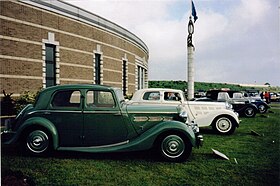Triumph Dolomite (1934–40)
| Triumph Dolomite | |
|---|---|

Dolomite Saloon 1938
|
|
| Overview | |
| Manufacturer | Triumph Motor Company |
| Production | 1934-1940 |
| Triumph Dolomite 8 | |
|---|---|
 |
|
| Overview | |
| Manufacturer | Triumph Motor Company |
| Production | 1934-1935 3 made |
| Body and chassis | |
| Body style | open two-seater sports-racing car |
| Powertrain | |
| Engine | 1991 cc straight-8 |
| Transmission | 4-speed preselector |
| Dimensions | |
| Wheelbase | 104 in (2,642 mm) |
| Triumph Dolomite | |
|---|---|

Dolomites on parade at Gaydon museum
|
|
| Overview | |
| Manufacturer | Triumph Motor Company |
| Production | 1937-1940 |
| Body and chassis | |
| Body style | 4-door sports saloon 4-seater Foursome drophead coupé Roadster (drophead coupé with dickey seat) |
| Layout | front engine rear-wheel drive |
| Platform | separate chassis frame is cruciform and underslung |
| Powertrain | |
| Engine | 1767 cc In-line 4 —14/60, 14/65 1991 cc In-line 6 —16, 2-litre 1496 cc In-line 4 —1½-litre |
| Transmission | mounted at four points as a unit with the engine: single dry-plate air-cooled clutch and 4-speed gearbox with syncromesh except on 1st, the power carried by needle roller bearing open propeller shaft to the helical bevel half-floating rear axle |
| Dimensions | |
| Wheelbase | 2,794 mm (110 in) track 52½ inches |
| Length | 4,496 mm (177 in) |
| Width | 1,702 mm (67 in) |
| Height | depends on body |
| Kerb weight | 1,245 kg (2,744 lb) 24½ cwt |
| 14 / 60 | |
|---|---|
| Combustion chamber | |
| Configuration | inline 4 |
| Displacement | 1767cc |
| Cylinder bore | 75mm |
| Piston stroke | 100mm |
| Cylinder block alloy | crankshaft on 3 main bearings |
| Valvetrain | pushrod operated overhead valves |
| Combustion | |
| Fuel system | twin horizontal carburetters with common air silencer, electric petrol pump |
| Fuel type | petrol |
| Cooling system | water with thermostatic control |
| Output | |
| Power output | 62 bhp at 4,500rpm RAC or tax rating13.95 hp |
The Triumph Dolomite is a car that was produced by Triumph Motor Company from 1934 to 1940. It first appeared in 1934 as a sports car and the name was also used from 1937 on a series of sporting saloons and open cars until 1939 when the company went into receivership. A number were still sold and registered in 1940, though it is uncertain whether the receiver or new owner turned out cars from spare parts, or sold off completed cars. All except the Straight 8 featured a "waterfall" grille styled by Walter Belgrove, versions of the saloons with conventional grilles were sold as Continental models.
The first use of the "Dolomite" name was in 1934, when it was used for an eight-cylinder sports car which resembled the Alfa Romeo 8C. However this car did not make production, with only three being made. The engine was of 1,990 cc capacity with twin overhead camshafts and fitted with a Roots-type supercharger. The engine output was 140 bhp (100 kW) at 5,500 rpm, giving the car a top speed of over 110 mph (180 km/h) when tested at Brooklands. Lockheed hydraulic brakes with large 16 in (410 mm) elektron drums were fitted. The channel-section pressed steel chassis was conventional with a beam front axle and half-elliptic springs all round.
One of the cars was entered in the 1935 Monte Carlo Rally driven by Donald Healey but was withdrawn after being written off in a collision with a railway train on a level crossing in Denmark.
Largely because of the financial troubles of the company, the car never went into production. Some spare engines and chassis were later assembled into complete cars by a London company called High Speed Motors (HSM).
A car as described above was displayed on Stand 135 at the Olympia Motor Show in October 1934 equipped with an Armstrong Siddeley-Wilson preselective gearbox. The wheelbase was eight feet eight inches and track was four feet six inches. It was priced at 1,000 guineas (£1,050). A new small Ford was available for £100.
The Dolomite name was again used from 1937 to 1940. The car this time had a 1,767 cc four-cylinder engine and saloon body. The design was overseen by Donald Healey and featured a striking new design of radiator grille by Walter Belgrove. The cars were marketed as "the finest in all the land" and targeted directly at the luxury sporting saloon market.
Triumph had been moving progressively upmarket during the 1930s, and the 1938 Dolomites were very well equipped, with winding windows in the doors, automatic chassis lubrication, a leather-bound steering wheel adjustable for rake and reach, dual hydraulic brake circuits, twin trumpet horns, and spot lamps included in the price. There was even a tray of fitted tools slotted beneath the driver's seat cushion, and for an extra 18 guineas buyers could specify a radio.
...
Wikipedia
